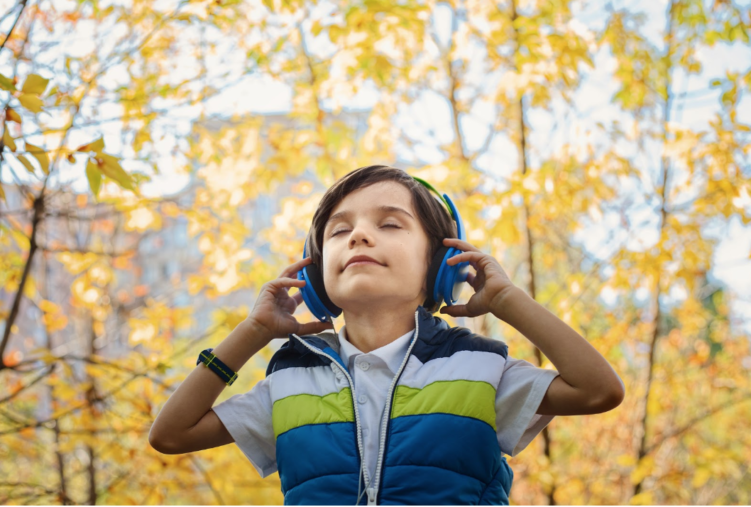With every beat that resonates through a song, an opportunity for toddlers to learn presents itself. Music is all around us, but did you know that music forms an integral part of early learning for toddlers? Indeed, the beat of nursery rhymes, popular music, and even your own parental creation can kick-start learning, promote development, and boost creativity.
Music is also a fun and exciting experience for toddlers. From the time they begin clapping their hands and stomping their feet (albeit out of rhythm) to the time they can actually sing along to the lyrics, music puts children on a continuous journey towards lifelong benefits.
How music can help your child
You may be wondering how music can help your toddler grow and develop. If you notice your child bobbing their head to background music or pushing their stuffed animals towards the rhythm of a beat, you should be excited as a parent. Music helps toddlers in the following ways.
It promotes brain development
From the time a child is born, they try to make sense of their environment. Toddlers begin analyzing tastes, colors, sounds and smells to process the vast amounts of information that surround them.
When your toddler is exposed to music, they become accustomed to a rich sensory environment. Music, coupled with other environmental cues, can create more neural pathways between a toddler’s brain and other cells in the body. These pathways allow toddlers to transmit and process information more efficiently. As a result, they will be able to perform better in school subjects such as math and reading.
Music encourages creativity and learning
If your toddler listens to and actively participates in music from a young age, they can eventually become more creative and skillful. Children are capable of learning basic nursery rhymes and eventually putting their own twist to the music. They will also gradually develop their counting, memory, and rhythm skills as they become more exposed to musical sounds.
And as your child listens to more songs, they will learn how to pick out what they like and understand it better over time. In fact, if you find your toddler humming or singing made-up songs, this is a sign of the brain and creativity in action; you can encourage this by getting your child gifts that are appropriate for their age to enhance their musical creativity.
It can create a soothing and comfortable atmosphere
As your child continues to make sense of their environment, music can create a comforting and soothing atmosphere. It’s not uncommon for children to sing to their dolls as they play, or even to hum loudly when feeling calm and jovial.
Music can also become a cue for your toddler. The child will eventually learn how to associate lullabies with naptime- or other theme-specific songs with appropriate action. For example, your child may know that it’s time to brush their teeth when they hear “brush, brush, brush your teeth” sang to the tune of “London’s bridge is falling down.”
Engaging your child through music
So now you know that music is an integral part of the development process in your child. But how can you turn some catchy tunes into learning experiences? The secret lies in making the experience more interactive.
In addition to the more passive listening that your toddler may experience while riding in a car, there are more engaging ways of making music the ultimate learning experience.
Make it fun and engaging
Your goal should be to make your child stomp their feet, clap their hands, and sway to the music. You can make music more engaging by sharing songs that come along with dancing motions. Try the “Itsy Bitsy Spider” or the “Hokey Pokey” as your toddler is sitting on your lap. Next, gently move your hips to the rhythm of the music and guide your child in waving their hands or bouncing their feet.
Teach rhythm
You can also spice up your child’s musical experience by teaching them basic rhythm skills. Give your child a plastic/wooden pot and pan and guide them in banging the pot as the beat of a song plays.
Encourage your child to bang or stomp according to their own created patterns. Over time, your child will develop their counting, timing-and-rhythm skills.
Incorporate an instrument
As your child gets older, you can add to the experience by giving them an instrument to play with. Children aged 1-3 years love simple instruments they can shake such as tambourines, rattles, and shakers. You can teach your child how to play these in time to classic and familiar tunes such as “row row row your boat.” Children between 2-3 years can also begin playing with recorders and even pipe whistles.
Finally, expose your child to more general music such as folk songs, classical-and-opera. Enrolling your child in a development-specific music class is also a worthwhile option to consider.


With every beat that resonates through a song, an opportunity for toddlers to learn presents itself. Music is all around us, but did you know that music forms an integral part of early learning for toddlers? Indeed, the beat of nursery rhymes, popular music, and even your own parental creation can kick-start learning, promote development, and boost creativity.
Music is also a fun and exciting experience for toddlers. From the time they begin clapping their hands and stomping their feet (albeit out of rhythm) to the time they can actually sing along to the lyrics, music puts children on a continuous journey towards lifelong benefits.
How music can help your child
You may be wondering how music can help your toddler grow and develop. If you notice your child bobbing their head to background music or pushing their stuffed animals towards the rhythm of a beat, you should be excited as a parent. Music helps toddlers in the following ways.
It promotes brain development
From the time a child is born, they try to make sense of their environment. Toddlers begin analyzing tastes, colors, sounds and smells to process the vast amounts of information that surround them.
When your toddler is exposed to music, they become accustomed to a rich sensory environment. Music, coupled with other environmental cues, can create more neural pathways between a toddler’s brain and other cells in the body. These pathways allow toddlers to transmit and process information more efficiently. As a result, they will be able to perform better in school subjects such as math and reading.
Music encourages creativity and learning
If your toddler listens to and actively participates in music from a young age, they can eventually become more creative and skillful. Children are capable of learning basic nursery rhymes and eventually putting their own twist to the music. They will also gradually develop their counting, memory, and rhythm skills as they become more exposed to musical sounds.
And as your child listens to more songs, they will learn how to pick out what they like and understand it better over time. In fact, if you find your toddler humming or singing made-up songs, this is a sign of the brain and creativity in action; you can encourage this by getting your child gifts that are appropriate for their age to enhance their musical creativity.
It can create a soothing and comfortable atmosphere
As your child continues to make sense of their environment, music can create a comforting and soothing atmosphere. It’s not uncommon for children to sing to their dolls as they play, or even to hum loudly when feeling calm and jovial.
Music can also become a cue for your toddler. The child will eventually learn how to associate lullabies with naptime- or other theme-specific songs with appropriate action. For example, your child may know that it’s time to brush their teeth when they hear “brush, brush, brush your teeth” sang to the tune of “London’s bridge is falling down.”
Engaging your child through music
So now you know that music is an integral part of the development process in your child. But how can you turn some catchy tunes into learning experiences? The secret lies in making the experience more interactive.
In addition to the more passive listening that your toddler may experience while riding in a car, there are more engaging ways of making music the ultimate learning experience.
Make it fun and engaging
Your goal should be to make your child stomp their feet, clap their hands, and sway to the music. You can make music more engaging by sharing songs that come along with dancing motions. Try the “Itsy Bitsy Spider” or the “Hokey Pokey” as your toddler is sitting on your lap. Next, gently move your hips to the rhythm of the music and guide your child in waving their hands or bouncing their feet.
Teach rhythm
You can also spice up your child’s musical experience by teaching them basic rhythm skills. Give your child a plastic/wooden pot and pan and guide them in banging the pot as the beat of a song plays.
Encourage your child to bang or stomp according to their own created patterns. Over time, your child will develop their counting, timing-and-rhythm skills.
Incorporate an instrument
As your child gets older, you can add to the experience by giving them an instrument to play with. Children aged 1-3 years love simple instruments they can shake such as tambourines, rattles, and shakers. You can teach your child how to play these in time to classic and familiar tunes such as “row row row your boat.” Children between 2-3 years can also begin playing with recorders and even pipe whistles.
Finally, expose your child to more general music such as folk songs, classical-and-opera. Enrolling your child in a development-specific music class is also a worthwhile option to consider.
Related Content: